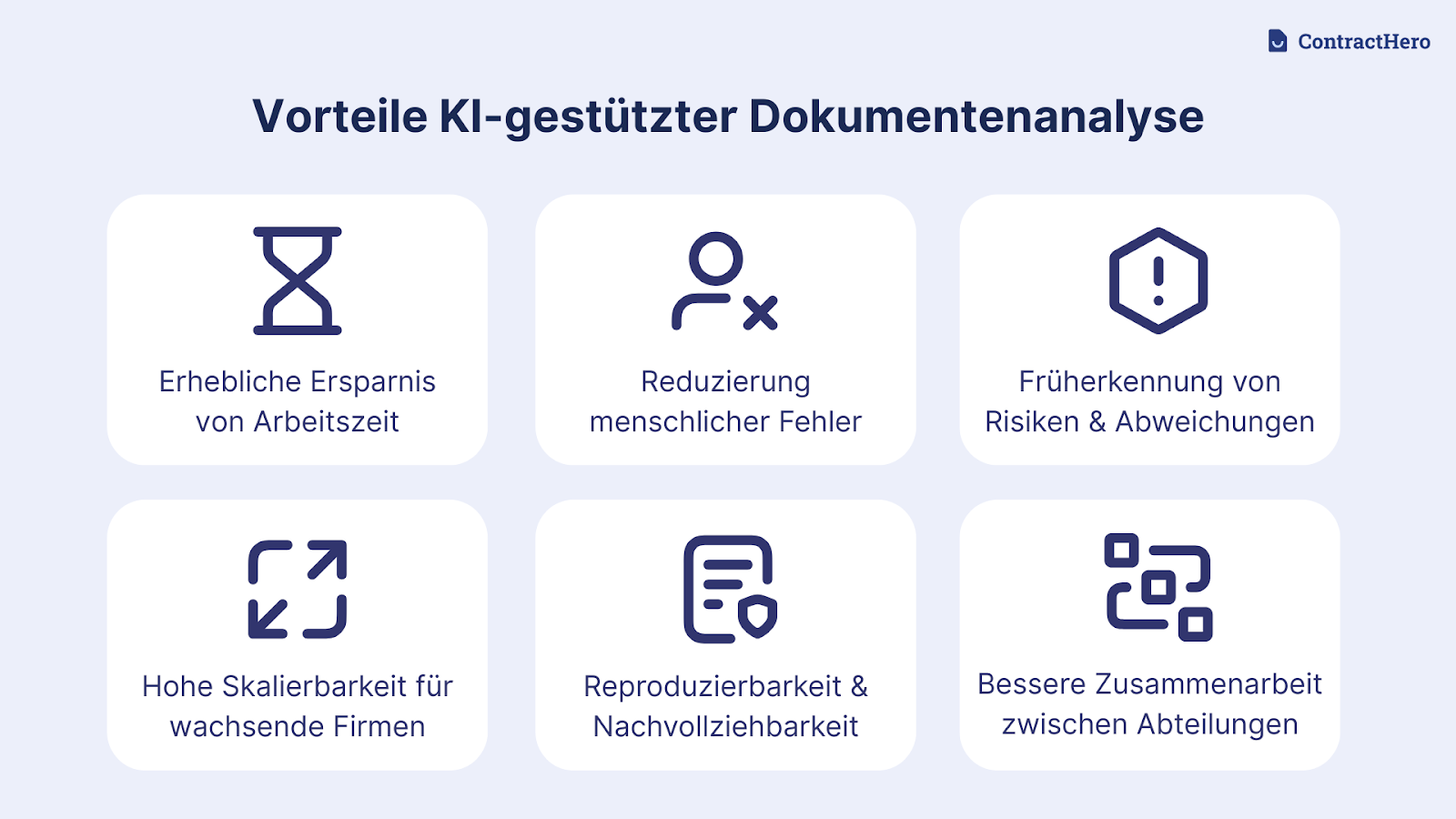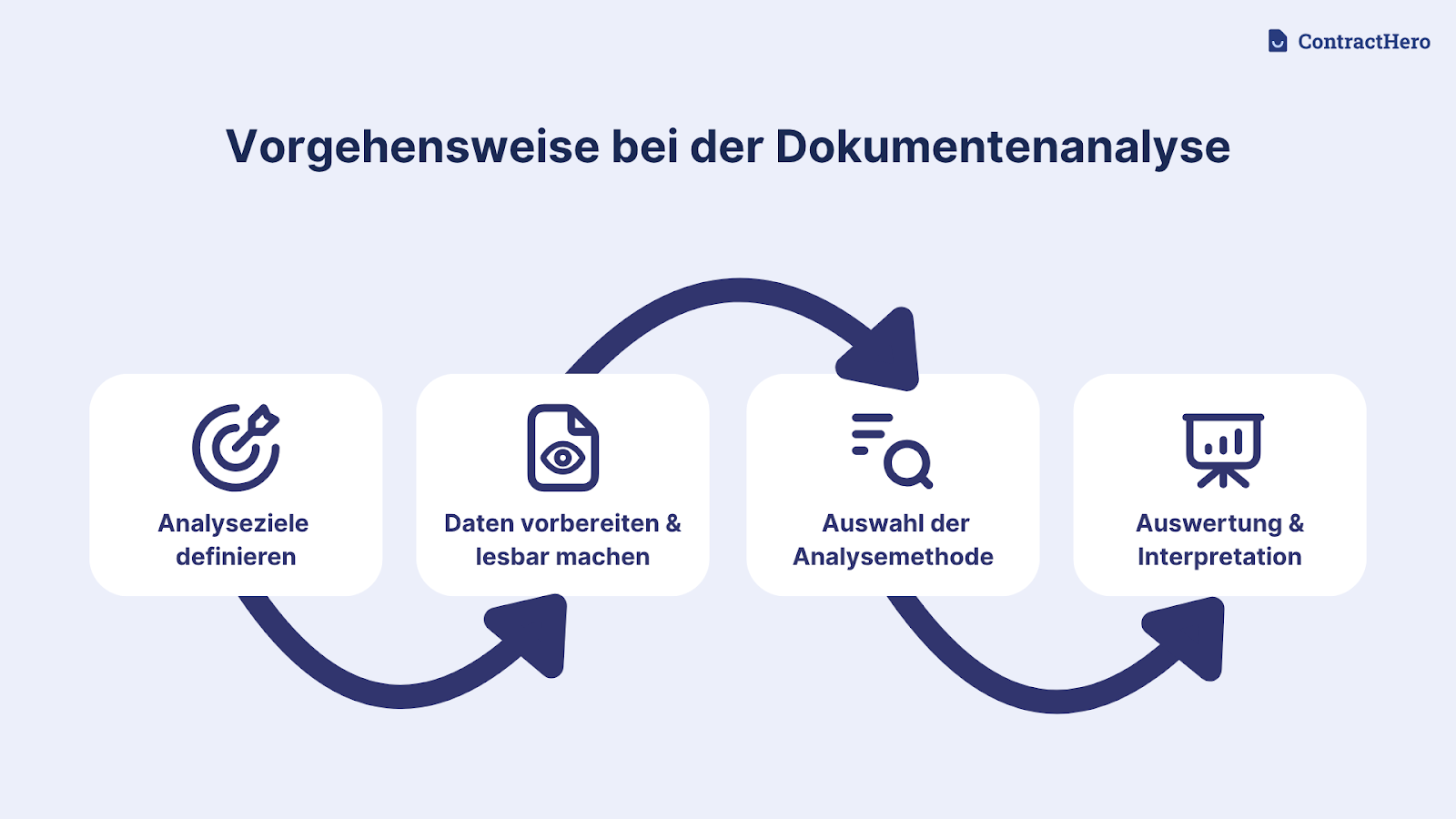
The analysis of documents and contracts is increasingly becoming a strategic task - especially in fast-growing, regulated or complex organizations. AI-supported processes not only provide an overview, but also real efficiency: they automatically identify risks, deadlines and clauses, reduce manual effort and enable data-based decisions. This makes AI document analysis a key instrument of modern corporate management. This glossary article shows how modern document and contract analysis works, where it is used and what companies should look out for.
Document analysis is a structured method for evaluating text documents with the aim of extracting relevant information and making it usable. While it was originally used in social research and administration, today it is particularly indispensable in digital contract and document management. The analysis focuses on content, linguistic patterns, logical structure and, if relevant, the context in which documents were created. In practice, it provides qualitative and quantitative findings, for example on deadline monitoring, compliance or risk assessment. For contracts in particular, it forms the basis for further checks or automated follow-up processes.
The use of artificial intelligence not only makes document content analysis faster, but also more precise and scalable. Technologies such as natural language processing (NLP) and machine learning make it possible to automatically read and interpret complex legal or commercial texts and evaluate the most important content in a structured manner. This means that even large volumes of contracts, guidelines or agreements can be captured efficiently - without manual checking processes. Legal, finance and compliance teams in particular benefit from AI-supported contract analysis because it identifies risks at an early stage and prepares operational decisions based on data. How exactly NLP and machine learning work and the specific benefits they offer are explained in detail in the "Use of modern technologies" section.
The use of digital, AI-supported technologies offers companies significant advantages over conventional manual verification processes. Especially in legally or financially sensitive areas, automation creates more speed, security and consistency. These are the most important advantages at a glance:

Modern text processing is based on two key technologies: Natural Language Processing (NLP) and Machine Learning (ML). Both work together to automatically understand and evaluate unstructured texts - such as contracts, general terms and conditions or guidelines.
In combination with OCR technology (text recognition in scanned PDFs) and semantic databases, the result is an analysis capability that can reliably process both structured and unstructured documents, regardless of format.
A common scenario: A contract states "Payment is due no later than 14 days after invoicing". An AI-supported contract analysis automatically recognizes the time reference (14 days) and the triggering factor (invoicing). This information is extracted and transferred to a deadline management system. ContractHero, for example, uses precisely such mechanisms to create automatic reminders and assign tasks on time - without manually setting deadlines. In this way, contract analysis becomes the basis for efficient workflows.
In order for the benefits of AI-supported document analysis to be felt in day-to-day work, the results must be seamlessly integrated into existing tools and processes. This is precisely where integration via APIs plays a key role. An API (Application Programming Interface) is a standardized interface through which two software systems communicate with each other, for example the analysis platform and an existing DMS (document management system), an ERP system (e.g. SAP, DATEV) or a CRM system (e.g. Salesforce). An ERP (Enterprise Resource Planning) manages accounting and controlling, for example, while CRM (Customer Relationship Management) manages customer relationships.
This is how integration works via a standardized API: Documents that are already available digitally - for example from a contract archive, an email attachment or cloud storage - are transferred to the analysis platform automatically or with a click. After the AI-supported analysis, the extracted information, such as deadlines, amounts or clauses, flows back into the target system in a structured manner. There they can be used directly, for example as a deadline in the calendar, as an assigned task in the workflow tool or as a new entry in the digital contract register.
For example, payment terms automatically end up in the accounting department or deadlines in the task lists of the specialist departments. An integrated workflow not only saves time, but also increases security and traceability when dealing with contracts. It is important that the integration is designed to be user-friendly - ideally without a high level of implementation effort or programming knowledge.
The areas of application of AI-supported technology for the preparation of documents are wide-ranging - especially where documents have legal, financial or operational relevance. In compliance audits, for example, content analysis helps to systematically identify critical clauses in relation to GDPR or other regulatory requirements. During risk analysis, the software automatically identifies potential weaknesses - for example in the form of unclear termination clauses, hidden liability provisions or missing term restrictions. It also provides support for more complex projects such as M&A due diligence, ISO certifications or exit preparation, where a structured and comprehensible contractual basis is crucial to success. In this way, companies create the basis for strategic decisions based on clear, structured data.
The structured processing of documents also plays a central role in contract management: deadlines, extension clauses and responsibilities can be automatically recorded and monitored. As part of contract analysis, a contract is systematically checked for relevant content. AI-supported contract analysis software detects weak points such as missing mandatory information or unfavorable contract terms. Risks can be prioritized, for example, by automatically categorizing them according to subject areas or contractual partners. This gives legal and finance departments an early insight into critical areas and enables them to react more quickly. This not only makes contract review more efficient, but also more strategic.
An AI-supported check is particularly suitable for structured and easy-to-read formats such as PDF, Word or digital contract files. Typical application examples are rental agreements, employment contracts, supplier agreements, but also general terms and conditions, guidelines or NDAs. It is important that the documents are available electronically and are clearly structured. Handwritten scans or widely varying layouts can impair the recognition quality - this may require pre-processing using OCR (Optical Character Recognition) or manual reworking.
The implementation of a professional document analysis follows a multi-stage, structured process - regardless of whether it involves contracts, general terms and conditions, internal guidelines or other business documents.

1. target definition: What information is to be recognized?
At the beginning, the content to be extracted from the documents is determined. This could be deadlines and amounts in contracts, for example, but also formulations on data protection, responsibilities, validity periods or mandatory components in NDAs.
2. data preparation: making documents machine-readable
In the second step, the documents are technically processed. Digital files are standardized and scans - from paper archives, for example - are converted into searchable text using OCR. This creates a standardized, analyzable format - regardless of file type or layout.
3. selection of the analysis method: rule-based or AI-supported
A decision is then made on how to analyze the documents. In addition to rule-based or semantic methods, many companies now rely on AI-supported processes. These not only recognize individual terms, but also correlations, omissions or deviations - e.g. in the case of atypical formulations in general terms and conditions or guidelines.
4. transition to evaluation: interpretation and use of the results
Thefinal step is the validation and interpretation of the analysis results - i.e. the targeted review, prioritization and structured processing of the extracted information. How this evaluation step actually works and which roles are involved is explained in detail in the next section.
After the AI-supported document review, the information obtained is prepared in a structured manner - for example in the form of reports, tables or directly integrated data records in systems such as contract databases, compliance dashboards or document management tools. The information is presented in such a way that legal, finance or operations teams can see at a glance which documents are complete, where risks exist or what content is missing. This includes not only traditional contracts, but also documents such as guidelines, general terms and conditions, non-disclosure agreements or internal compliance documentation. The analysis automatically recognizes whether certain passages are included, whether legally relevant terms have been used correctly or whether clauses differ from one another.
This creates a sound basis for review or decision-making processes - for example, for assessing legal compliance, contract maturity or the need for revision. For example, a data protection clause may formally exist, but whether it complies with the latest requirements of the GDPR often needs to be checked in detail. Document analysis makes this check much easier - it ensures that nothing is overlooked and that all relevant text modules are systematically recorded.
Modern solutions such as ContractHero combine AI-supported evaluation directly with intuitive workflows. The system automatically recognizes terms, extension clauses, responsibilities, payment terms or risky formulations. The analyzed information is clearly prepared and integrated directly into the central contract register - without having to go through third-party applications. User-friendliness is a major advantage: even users with little legal or technical experience can gain well-founded insights with just a few clicks. Modern tools also offer extensive integrations, for example with DATEV, Salesforce or Microsoft 365, allowing data processing to be seamlessly integrated into existing system landscapes. Important for all companies with high data protection requirements: The software must be GDPR-compliant and ideally hosted in the EU.
Despite all the advantages, automated document analysis also presents challenges. Recognition errors can occur, particularly with unstructured or complex contracts - for example with special legal clauses, industry-standard abbreviations or linguistic ambiguities. The quality of the source documents also plays a decisive role: blurred scans, illegible PDFs or unusual layouts reduce the accuracy of the analysis. Another obstacle can be integration into existing IT landscapes - especially if there are no standardized interfaces (APIs) or existing systems have a proprietary structure. Last but not least, data protection is a critical factor: anyone analyzing personal or confidential contract content must meet the highest security and compliance standards. It is therefore advisable to thoroughly check both the technical requirements and the legal framework before introducing document analysis software.